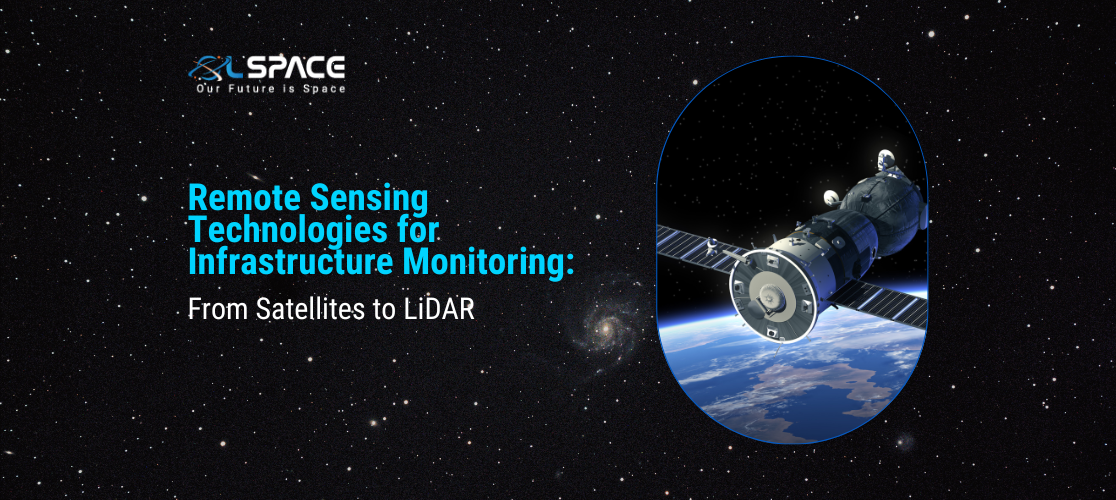30 January 2024
Remote Sensing Technologies for Infrastructure Monitoring: From Satellites to LiDAR

Infrastructure monitoring plays a critical role in maintaining the safety, functionality, and sustainability of various structures, including roads, bridges, pipelines, and buildings. Remote sensing technologies have emerged as powerful tools for collecting valuable data for infrastructure monitoring. This article explores the diverse range of remote sensing technologies, from satellites to LiDAR (Light Detection and Ranging), and their applications in monitoring and managing infrastructure assets.
1. Satellite Imaging:
Overview: Satellites provide a global perspective, capturing high-resolution images of large areas. Satellite imagery is invaluable for monitoring infrastructure networks, assessing environmental changes, and identifying potential risks.
Applications:
Urban Planning: Satellite imagery aids in urban planning by assessing land use, identifying changes in infrastructure, and supporting the development of smart cities.
Natural Disaster Monitoring:Satellites can quickly capture the impact of natural disasters on infrastructure, enabling rapid response and recovery efforts.
Vegetation Management: Monitoring vegetation around infrastructure, such as power lines and pipelines, helps prevent vegetation-related issues and ensures the reliability of critical assets.
2. Aerial Photography:
Overview: Aerial photography involves capturing images from aircraft, drones, or unmanned aerial vehicles (UAVs). This technology provides high-resolution imagery and is particularly useful for localised infrastructure monitoring.
Applications:
Construction Site Monitoring: Aerial photography aids in tracking construction progress, identifying potential issues, and ensuring compliance with design specifications.
Pipeline Inspection: Drones equipped with cameras can inspect pipelines for signs of corrosion, leaks, or encroachments, enhancing the integrity management of pipeline networks.
3. LiDAR (Light Detection and Ranging):
Overview: LiDAR technology uses laser beams to measure distances and create detailed, three-dimensional maps. It is particularly effective for capturing precise topographic and structural data.
Applications:
Topographic Mapping: LiDAR produces highly accurate elevation models, supporting topographic mapping for infrastructure projects, floodplain analysis, and terrain modeling.
Structural Monitoring: LiDAR can detect subtle movements or deformations in structures, providing early warnings for potential structural issues.
Road and Rail Monitoring: LiDAR is used for monitoring the condition of roads and railways, assessing factors such as surface quality and alignment.
4. InSAR (Interferometric Synthetic Aperture Radar):
Overview: InSAR is a radar-based technology that measures ground deformation by analysing the phase difference of radar signals over time. It is particularly useful for monitoring subsidence, landslides, and other ground movements.
Applications:
Subsidence Monitoring: InSAR is employed to monitor ground subsidence caused by factors like mining activities, groundwater extraction, or natural geological processes.
Infrastructure Stability: It helps assess the stability of infrastructure, such as dams and bridges, by detecting deformations that may indicate potential issues.
5. Thermal Imaging:
Overview: Thermal imaging sensors capture infrared radiation to create thermal maps, revealing variations in temperature. This technology is valuable for identifying thermal anomalies in infrastructure.
Applications:
Building Inspections: Thermal imaging is used to detect heat loss, insulation issues, and electrical anomalies in buildings, contributing to energy efficiency and safety.
Power Line Monitoring: Thermal imaging helps identify hotspots in power lines, transformers, and other electrical components, aiding in preventive maintenance and risk mitigation.
6. IoT Sensors:
Overview: Internet of Things (IoT) sensors can be strategically placed on infrastructure assets to collect real-time data on various parameters, including temperature, vibration, and structural strain.
Applications:
Bridge Health Monitoring: IoT sensors on bridges can provide continuous data on structural health, enabling predictive maintenance and early detection of potential issues.
Pipeline Integrity Monitoring: Sensors on pipelines detect changes in pressure, temperature, and flow, helping ensure the integrity and safety of the pipeline network.
Conclusion: Integrating Technologies for Comprehensive Monitoring
The integration of diverse remote sensing technologies offers a comprehensive approach to infrastructure monitoring. By combining the capabilities of satellites, LiDAR, aerial photography, InSAR, thermal imaging, and IoT sensors, infrastructure managers gain a holistic understanding of asset conditions. This multi-faceted approach enhances decision-making, enables preventive maintenance, and contributes to the overall resilience and sustainability of critical infrastructure networks. As technology continues to advance, the synergy of these remote sensing technologies will play an increasingly vital role in shaping the future of infrastructure monitoring.
